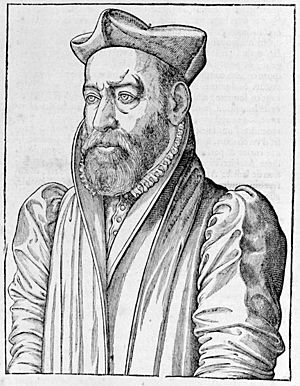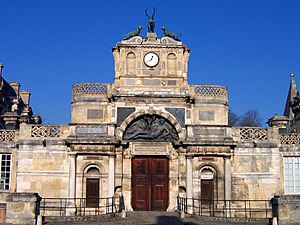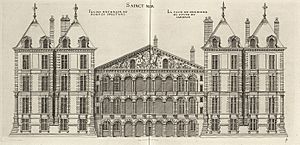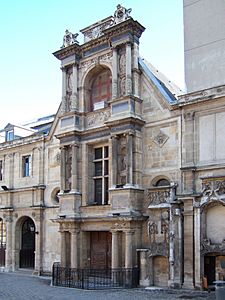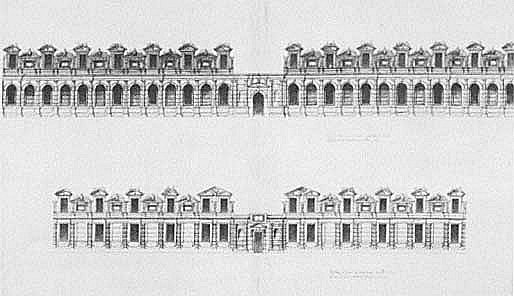Philibert de l'Orme facts for kids
Philibert de l'Orme (born between June 3 and 9, 1514 – died January 8, 1570) was a famous French architect and writer. He was one of the most important figures in French Renaissance architecture. You might also see his name written as De l'Orme, de L'Orme, or Delorme.
Contents
Philibert's Life Story
Starting His Career

Philibert de l'Orme was born in Lyon, France. His father, Jehan de L'Orme, was a skilled builder who ran a big construction business. When Philibert was 19, he traveled to Italy and stayed there for three years. He even worked on building projects for Pope Paul III.
While in Rome, he met Cardinal Jean du Bellay, who was the King of France's ambassador. Du Bellay became his supporter and a client. Around 1540, Philibert moved to Paris and soon started working on projects for the French royal family.
Architect for King Henry II (1548-1559)
On April 3, 1548, King Henry II officially named Philibert his royal architect. For 11 years, Philibert oversaw almost all of the King's building projects. Some of his most important works included the Château de St Maur-des-Fossés, the Château d'Anet, and the Château de Chenonceau in the Loire Valley. He also worked on the royal Château de Madrid and made big changes to the Palace of Fontainebleau.
Philibert was also known for his writing and new building ideas. He created a special way to build the wooden frames for stone buildings. This method, called charpente à petits bois, was faster and cheaper. It also used less wood. He showed it to the King in 1555 and used it for the Château de Montceaux and the royal hunting lodge La Muette.
A Time of Change (1559-1563)
When King Henry II of France died on July 10, 1559, Philibert suddenly lost his main supporter. Other architects who were jealous of his success quickly replaced him. Just two days later, he was removed from his royal jobs. An Italian architect, Francesco Primaticcio, who was very popular at the time, took his place.
Philibert decided to focus on studying and writing. He traveled to Rome again to see the new works by Michelangelo. In 1565, he started writing a book about architectural theory. This book was very scientific and philosophical. It was published in 1567 and became an important textbook for many years.
Back in Favor (1563-1570)
Under King Charles IX and Catherine de Medici, Philibert returned to working for the royal family. He helped make the Chateau of Saint Maur bigger in 1563. He also worked with Jean Bullant on additions to the Tuileries Palace starting in 1564. Philibert died in Paris in 1570 while this project was still being built.
His Lasting Impact
After Philibert's death, during the time of Louis XIV style architecture, his reputation wasn't as strong. Some of his buildings were even torn down to make way for new, more classical styles. In 1683, a famous architect named François Blondel criticized his work.
However, Philibert's two main books on building and design remained very important. They were reprinted often and continued to be studied. His reputation grew again in the 1700s. Writers like Dezallier d'Argenville praised him for moving French architecture away from older styles and towards the look of Ancient Greece.
One of Philibert's biggest achievements was changing how architects learned and worked. He believed architects needed formal education in classical architecture, geometry, and science. But he also stressed the importance of hands-on experience in building. He himself was a great scholar of ancient Greek and Roman architecture. He thought architects should be able to design and manage every part of a building, from planning to calculating costs. He didn't like architects who could only design a pretty front but knew nothing about actual construction.
Another major accomplishment was his effort to create a unique French architectural style. While he studied and learned a lot from Italy, he always added a distinct French touch to his projects. He didn't just copy Italian designs.
Buildings by Philibert de l'Orme
-
Court facade of the Château d'Anet, now serving as the facade of the chapel at the Ecole Nationale des Beaux-Arts in Paris
-
The bridge over the Loire of the Chateau de Chenonceau was designed and built by de l'Orme (drawing by Jacques Androuet du Cerceau)
Philibert's first major building was the Château of Saint Maur (1541). He built it for Cardinal Jean du Bellay, whom he had met in Rome. This castle showed influences from Italian villas and was decorated with beautiful paintings.
Sadly, many of his works no longer exist. However, his fame continues. He was a strong believer in Humanism and studied ancient art, but he also strongly supported French traditions in architecture. He was an independent thinker with original ideas. His most famous work was the Château d'Anet (1552–1559), built for Diane de Poitiers. Although only part of the building remains, its plans are preserved in a famous book by Jacques I Androuet du Cerceau. His designs for the Tuileries Palace, started by Catherine de' Medici in 1565, were also magnificent. You can also see his work at Chenonceau and other famous castles. His tomb for King Francis I at Saint Denis Basilica is a perfect example of his artistic skill.
The easiest place to see Philibert de l'Orme's work in Paris is the court facade of the Chateau d'Anet. This part of the castle was moved to Paris after much of the original building was taken down. It was moved to help students learn about important French Renaissance works. It is now attached to the front wall of the chapel at the Ecole des Beaux-Arts and can be seen from Rue Bonaparte.
Some of His Works
- Château de Saint-Maur (1541), torn down in 1796
- Tomb of François Ie in the Basilica of Saint-Denis, Paris (1547)
- Château d'Anet (1547-1555), built for Diane de Poitiers. Only one part of it remains.
- Plans for the Chapel of Saint-Éloi, Paris (1550-1566)
- Completion of Sainte-Chapelle at the Château de Vincennes (1552)
- Château de Villers-Cotterêts, southern part (1547-1559)
- Chapel of the Château of Villers-Cotterêts (1552-1553)
- Royal Château of Saint-Léger-en-Yvelines (torn down)
- Château de Montceaux
- Château de Thoiry (1560s)
- The bridge that the Château de Chenonceau is built upon
- Parts of the Louvre
- Parts of the new Chateau of Saint-Germain-en-Laye
- Entrance of Château d'Écouen, now the National Museum of the French Renaissance (mid-16th century).
- Roofs of the towers of the Château de Bonnemare.
See also
 In Spanish: Philibert de l'Orme para niños
In Spanish: Philibert de l'Orme para niños
- Catherine de' Medici's building projects
- Basilica of the National Shrine of the Assumption of the Blessed Virgin Mary, influenced by Philibert Delorme


